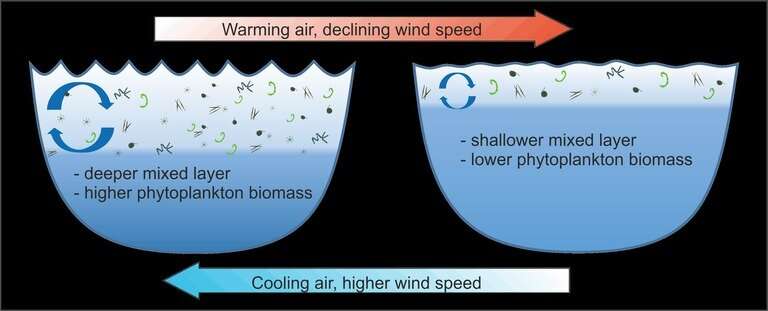Credit: University of Jyväskylä
A recently published study showed that heat waves reduced the biomass of phytoplankton in a boreal lake. Summertime heat waves will become more frequent and stronger with climate change and can reduce the biomass of phytoplankton in stratified lakes.
Researchers at the Department of Biological and Environmental Science at the University of Jyväskylä followed the daily biomass of phytoplankton and environmental conditions in a humic lake Jyväsjärvi in central Finland during a summer stratification period.
During that period, warmer and less dense surface water forms a mixed layer above colder and denser water at deeper depths. Phytoplankton occur mostly in the mixed layer, the depth of which is regulated by weather. The depth of the mixed layer controls light and nutrient availability of phytoplankton. Phytoplankton receive less light but more nutrients with an increasing depth of the mixed layer. Phytoplankton needs both light and nutrients for photosynthesis.
"We found that the depth of mixed layer controlled the biomass of phytoplankton. The biomass increased with deepening of the mixed layer and decreased with shallowing of the mixed layer. Phytoplankton is responsible for the primary production in lakes and thus its biomass is the source of energy to other aquatic organisms including fish," says the lead author of the study Salla Ahonen, a doctoral researcher at the Department of Biological and Environmental Science.
Climatic drives such as wind speed and temperature difference between air and water regulate the depth of the mixed layer. During heat waves, warm and calm weather reduces the depth of the mixed layer, whereas colder and windy weather deepens the mixed layer. Warming climate will increase heat waves and thus the conditions that can reduce phytoplankton biomass in lakes.
The research is published in the journal Freshwater Biology.
More information: Salla A. Ahonen et al, Increasing air temperature relative to water temperature makes the mixed layer shallower, reducing phytoplankton biomass in a stratified lake, Freshwater Biology (2023). DOI: 10.1111/fwb.14048
Provided by University of Jyväskylä
























